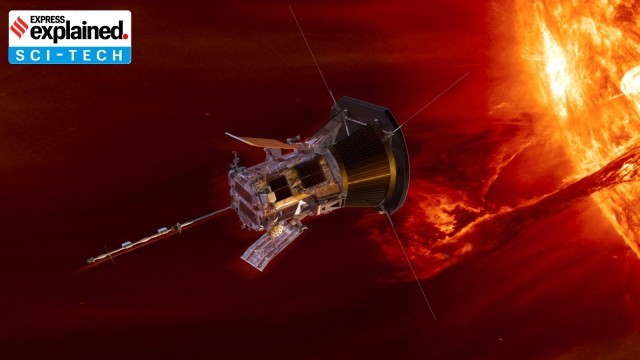Parker Solar Probe’s Closest-Ever Approach to the Sun

- 28 Dec 2024
In News:
NASA scientists announced that the Parker Solar Probe survived the closest-ever approach to the Sun. The craft was operating normally after it passed just 6.1 million km from the solar surface.
About the Parker Solar Probe:
- Launched: August 12, 2018, as part of NASA’s Living With a Star program.
- Named After: Eugene Newman Parker, a solar astrophysicist, marking the first NASA mission named after a living researcher.
- Mission Objectives:
- To study the Sun’s corona and the solar wind, investigating why the corona is hotter than the Sun’s surface.
- To explore the origins of solar winds and high-energy particles that impact space weather.
- To understand the structure and dynamics of plasma and magnetic fields around the Sun.
- To examine the mechanisms behind the acceleration and transportation of energetic particles.
Technological Feats:
- Heat Shield: Equipped with a 4.5-inch carbon-composite shield that withstands temperatures up to 1,377°C (2,500°F) while keeping the instruments cool at about 29.4°C (85°F).
- Speed: Travels at a speed of 692,000 km/h (430,000 mph), making it the fastest human-made object.
- Venus Flybys: Uses gravitational assists from Venus to gradually reduce its orbit and get closer to the Sun.
Historic Milestone:
- Closest Approach: On December 24, 2024, Parker Solar Probe reached a historic distance of 6.1 million km from the Sun's surface, the closest any human-made object has ever been.
- Comparison: If the Earth and Sun were 1 meter apart, Parker Solar Probe would be just 4 cm from the Sun.
- Temperature: At its closest, it endured temperatures up to 1,377°C.
Significance of the Mission:
- Scientific Contributions:
- Solar Wind: Helps scientists understand the origins of solar winds, which affect space weather and Earth’s technological systems.
- Corona Heating: Investigates why the Sun's corona is much hotter than its surface (a long-standing astrophysical mystery).
- Space Weather: Provides critical data for predicting space weather events that can impact satellites, communication systems, and power grids on Earth.
- Practical Implications:
- Improves understanding of space weather, potentially aiding in the protection of Earth’s infrastructure from solar storms.
- Technological and Engineering Marvel:
- Demonstrates advanced spacecraft technology that can withstand extreme conditions close to the Sun.
Recent Developments:
- Data Collection: As the probe passed through the Sun’s outer atmosphere (the corona), it collected valuable data expected to answer fundamental questions about solar behavior.
- Communication: Despite the extreme proximity to the Sun, the probe sent back a signal on December 26, confirming its status.
Key Dates:
- Launch: August 12, 2018.
- Closest Approach: December 24, 2024.
- Data Expected: Detailed telemetry data on January 1, 2025.
